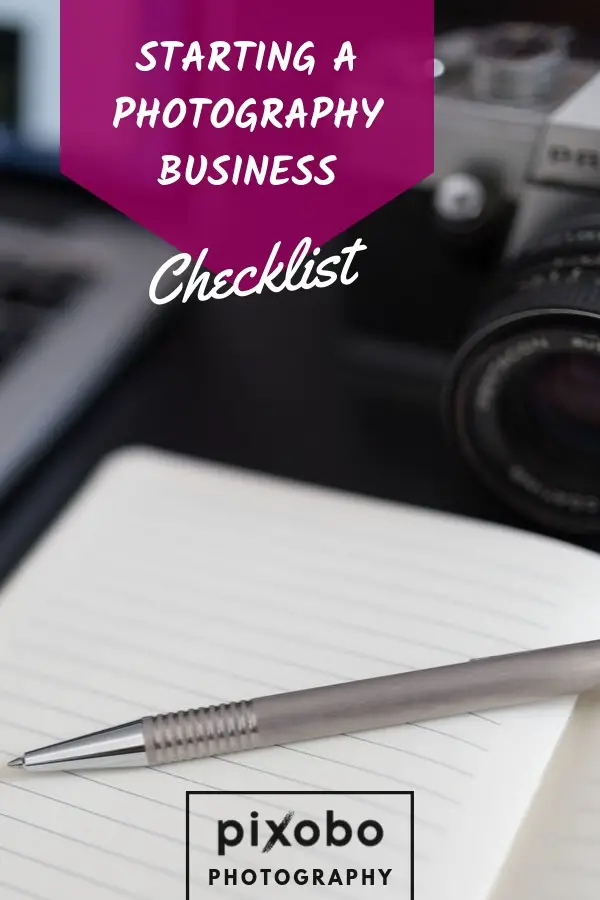Always wanted to be self-employed? You are sick and tired of working for someone else? Or you already have a running business but you are not happy with the profit? You are at the right place. We made starting a photography business checklist. This checklist creates fundamentals for every successful photography business. Here is the thing.
How do you start your photography business and bring it to a level where both your revenue and profits are increased? Your progress is connected with your style of life, because with increasing sales and profit your satisfaction increases and in the same breath your freedom of movement. What does “freedom of movement” mean? This describes you as a free person. You are your own man, you make the decisions. For example, you can take some free time and go travel whenever and wherever you want.
Related: How to Start a Photography Business on the Side?
Table of Content
Financial Security Will Create the Life You Always Wanted

With a degree of financial security, you can create space for yourself. Free time carefully crafted as a result of your own photography business to do everything that is important to you in your life. Getting to this level is hard and it takes time and devotion. Luckily, we can give you some advice to propel you into the life you always wanted.
As an independent service provider, you are the product yourself. That’s exactly why selling “yourself” is usually difficult. We are going to give you pointers on how to set up your photography business the right way. With this, you won’t have the stressful beginning that almost every photography business has at the start.
Related: How To Start A Photography Business
Photography Business Quantum Leap?

Promote your business and make a quantum leap. To do this, start by analyzing the current status of your business or your business idea. For your convenience, I provided you with the most important questions that you should answer honestly for yourself in order to have any profit or sales in the future. The more merciless you are, the more benefits you will have! With the help of your answers, you will see the starting points in your photography business that you need to focus on in order to get your business going.
Starting at the base, you progress step by step to the last point that symbolizes your income. In order to establish a high income, we need a stable basis – and the more stable it is, the more security and strength you have on your way up towards your goal.
Related: Is Photography A Good Career For You? Top 15 Warning Signs That It’s Not
1. Your Personal Goals

You need to know your personal goals. They are important to define because they represent your drive and they will be your guide to the life you always wanted. Now you will surely think that goals are nice and good for your own motivation? Trust me you need more. Think about things you don’t want to do. For example, hard and dirty jobs that take away any free time to do important things in your life. They are also excellent motivation for starting your own photography business.
Take time to answer the following questions and remember: the more honest you answer them, the better.
- What are my goals?
- Are these goals defined in concrete terms?
- Do these goals represent a source of motivation for me?
- Why do I want to achieve with this?
- What I really don’t want to experience anymore?
Write them down. These answers are the foundations that will drive you to the profitable photography business.
2. It’s All an Attitude Thing

Beliefs. And I’m not talking about beliefs relating to the market, customers or your competition. This is relating to what you think about yourself because the income of your work is closely linked to your view of yourself. Your beliefs concerning your attitude, world view and consideration of your own personality are irrelevant to your rational thinking but firmly anchored in your subconscious. Of course, it goes both ways. If your attitude is motivating, such as “I see my great strength in winning new customers!”, it will have benefits. Conversely, if you’re convinced of “My customers would never pay me an hourly rate of $ 100!”, that will hugely hinder you from building your photography business!
In order not to fail at recurring patterns and hurdles, reflect on your answers with these following questions:
- Do I have positive thoughts about myself? Which are they?
- What negative beliefs do I have about me?
- Where do these beliefs come from? Were there incidents in the past?
- How much am I worth to myself and others? (Consider different hourly or daily rates, then ask yourself – intuitively – Where do I see my value?).
Related: 23 Photography Quotes That Will Give You Hope In Photography
3. Your Business Model and Your Positioning

This is about clearly positioning yourself and your type of photography business. The clearer it is, the more beneficial it will be for your income. You’ll be recognized faster, your work will be easier to grasp for your potential customers and it will be easier for them to recommend you. In addition, with your clear positioning, your status as an expert also increases. Higher expert status equals a higher fee. In the photography sector, there are striking differences between “beginner” service providers and top-positioned experts. Positioning yourself correctly also means that your target group knows your ideal customers and addresses them accordingly. The smoother this process is, the better the customer acquisition process will be. With this order, volume and income will increase.
The following questions will help you with this step:
- What is my business? What do I stand for?
- Is it exciting what I do for a living?
- Am I good at it?
- Is my offer interesting for the market?
- How big is my market?
- Who are my ideal customers?
- Where is the benefit of this?
Related: 5 Surprising Things Holding Your Photography Business Back
4. More Activities with More Value

Increase your productivity by clearly classifying your actions. Take high value jobs and do it yourself. For example, wedding photography. Other types of photography that cost less you can leave them to your competition of they are doing it cheaper.
Only if you know how much your time is worth, you can communicate that to others!
Ask yourself these questions:
- How much is worth to me?
- What am I doing during this time?
- Where is the value for my work?
- Which tasks should I do myself and why?
- Which areas can I give, because someone else can handle them just as well (and much cheaper)?
Related: What Is The Most Profitable Photography Niche?
5. Your Performance Is Your Product

This step is done when you know what you stand for and who your customers are. Then develop your product. By a product, we mean a specific type of photography you are going to be focusing on. How to increase your performance? Read more about that type of photography. Try consulting or courses. Find a mentor that can guide you. Later find types of photography that make your income more independent of your time and attendance. Create different offers that go well with your product. When you have done, you will be less comparable to your competitors. Thus, your offer is also more difficult for your customers to compare with other competitors (price). An important point, because the deciding factor is not your price, but the value you offer to your customer!
Answer these questions:
- Can I pack my offer into products or just sell my time?
- Do I already have products?
- If so, which ones are still missing to serve certain price ranges?
- Are there any products that turn prospects into customers?
6. Outside Picture

After successfully defining your positioning and products, we need to work on the outside picture. Now you are permanently marketing yourself. The points of contact are many. Potential customers, media, the public, business partners, suppliers or even banks will meet you at these so-called touchpoints. Your web presence (website, social media), your business cards, your voice-box text, your company car up to your own appearance: everything looks outward. The first impression counts. Alleged little things like business cards, unclean shoes or a not updated LinkedIn profile represent “vulnerable” goals for a diminished perception of your competence.
Optimize your touch-points and ask yourself:
- Who are the relevant contact groups in my business environment?
- Where are my points of contact with them?
- What is the effect of each touchpoint? (Ask others too)
- How do I optimize them?
Related: Pinterest For Photography Business: Best Platform For Photographers?
7. Marketing and Sales Processes

You have perfected your knowledge created a service or a product that you can offer to customers. Now you are eager to get that product to customers. How to get new customers? For a better illustration, visualize a funnel where you fill it up with contacts and down they will come out as shopping customers. Develop systems that feed your funnel regularly and minimize the loss of interest in the same breath. Use (technical) tools that automate activities and processes, and thus provide incredible relief for you and your business.
Answer the following questions:
- How do I generate new contacts?
- Do I already have processes to get new contacts?
- Which systems for regular funnel feeding could I set up?
- Do I have a process to make new deals for existing customers (and grow the business with them)?
Related: Profitable Photography: Selling Stock Photos For Beginners
8. Your Interaction with Potential Customers

If you have successfully completed and edited all of these questions, next that follows is your personal interaction with (potential) clients. This point is not to be underestimated. It decides your behavior when dealing with your customers. Ultimately if all your preparatory work now bears fruit your offers will pass into an order. Here you can win everything, but also lose everything. Therefore, be sure to conduct your customers professionally and successfully. A skill you should work on constantly.
Reflect on your answers to the following questions:
- Where are the crucial points in my conversation?
- Do I have enough exercise for this?
- How do I quickly establish a good relationship with my counterpart?
- Am I making (price) objections out of balance?
- How do I respond the best?
- Where is my graduation rate for discussions?
Take time to answer all these questions for you. You can ask outsiders to include their views on you and your business. However, you are designing this process, make choices, commit yourself to your goals, and put all your energy into realizing your potential.
Related: How To Deal With Difficult Photography Clients?
For those who already have a business plan or they are trying to create one we also compiled a checklist.
The Business Plan – A Checklist

Your individual business plan requires specific content that is essential for planning. The legal form is not included here.
1. Management – Are You the Right Person to Start Your Business?
- Do you have extensive knowledge of the photography industry?
- Any sufficient commercial knowledge?
- Do you have the required qualifications and approvals?
- Is your personality strength in the management?
- Do you have any personal deficits? (eg Time limitation due to family obligations?
– and if so, how are these compensated?
Related: 13 Reasons To Give Up Photography Business And Do Something Else
2. Business
- Are you distributing a product or offering a service?
- What is the salient feature of your business idea?
- What is the goal of your company?
- When can a product be distributed/offered a service?
- Which product is distributed/what service is offered?
- When can a product/service be marketed?
- Which official formalities are associated with this?
3. The Photography Industry
- Which customers are your target audience?
- How can you be reached by the customers?
- How is your target group composed? (Statistical)
- Do you need many customers or are you dependent on a few large orders?
- What do your customers need?
4. The Competition
- Does the competition offer a better product/service?
- Who is your competition?
- What are the strengths of your competition? What are the weaknesses?
- In comparison what strengths/weaknesses does your company have?
- How can they overcome any weaknesses?
5. Location
- Where do you offer your product/service?
- What advantages and disadvantages does the desired location have?
6. Concept and Employees
- How can you give an overview of the company? (Are you a shareholder or a managing director? / How many employees do you need? / How many employees can you afford? / Where is your seat? / What is your company’s purpose? / Do you have any rights, patents, qualifications and licenses?)
- Is your company still developing? Are you standing right in front of the foundation? How do you plan the growth?
- When do you want to hire employees?
- How much can you spend on employees?
- What qualifications do your employees need?
7. Assessment of Risks
- What opportunities do you see for the positive development of your company? Why should it flourish?
- Which risks can make the positive development of your company more difficult?
- How can you handle these risks?
8. The Financial Plan
- The settlement of a comprehensive financial plan is of immense importance.
- What is your capital requirement for all purchases and costs during the so-called “start-up phase”? (half a year after foundation)
- What is your own share of the capital? `
- What is the foreign share of the capital?
- Do you have collateral for possible bank financing?
- What state funding can be achieved?
In the forecast in 3 years:
- What is the monthly investment of capital?
- What are the monthly costs?
- How high can your monthly debt service (ie repayment and interest on loans) be canceled?
- What is your monthly capital reserve?
- Calculate your expected sales/profit?
- What are the expected costs?
Related: How Much Does It Cost To Start A Photography Business In 2019?
9. Marketing
- What is the purpose of your product/service for customers?
- How does your product/service outperform the competition?
- What price do you want to set? What kind of strategy are you pursuing?
- How do you calculate the price?
- How high are the costs through sales/offer?
- What are your planned sales sizes?
Related: 9 Myths About Photography Business You Can’t Afford To Believe!
Don’t belong to the type of people who will forever stay in their comfort zone but go beyond this point and stand by with your decisions, because you deserve to be successful.
Best of luck in your photography business!
Related: Best Photography Names: How To Name Your Photography Business




